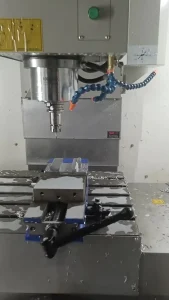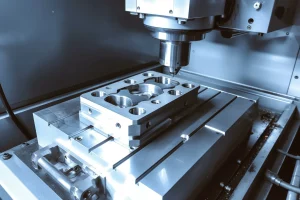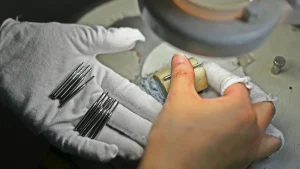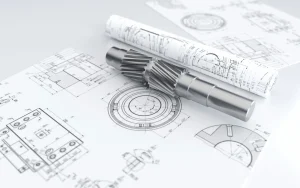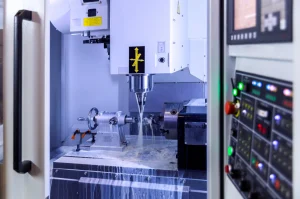在机械制造领域, 数控系统 (计算机数控) 机械加工不再是一个陌生的词. It represents a modern manufacturing method with high precision, 高效率, and high flexibility, revolutionizing the face of traditional machining. 所以, how exactly does CNC machining work? Why has it become an indispensable core technology in modern industry? This article will delve into the industry knowledge of CNC machining, revealing the technical logic and application value behind it.
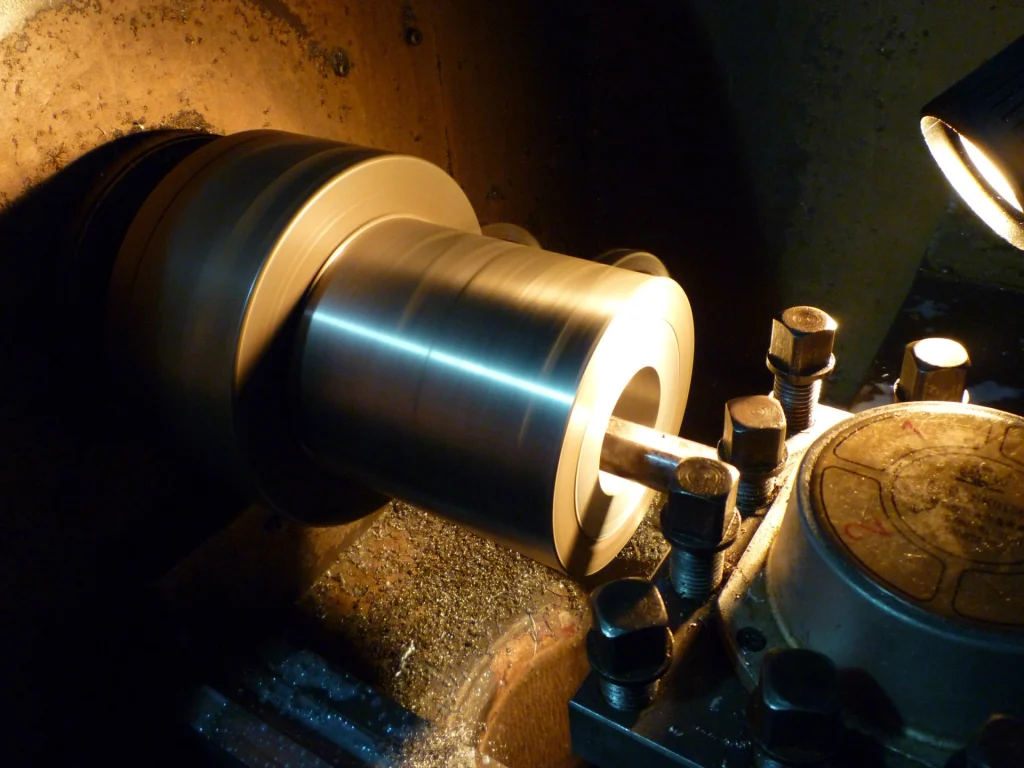
The Essence of CNC Machining: Precision Manufacturing Driven by Digital Commands
其核心, CNC machining lies in the transformation of design drawings, typically CAD models, into machine-recognizable G-code through CAM software. These codes precisely control the tool path, rotational speed, feed rate and other parameters of the machine tool, driving the machine tool spindle and worktable to move in coordinated movement in three-dimensional space, thereby cutting complex shapes on workpieces such as metals, 塑料, 和复合材料. Its core advantages are:
1. 精度和一致性: Micron-level (μm) accuracy can be easily achieved, with a high degree of consistency in mass production, far from being comparable to traditional manual operations.
2. Complex Geometry: Easily control geometries such as complex surfaces, 腔, and special-shaped holes that are difficult to achieve with traditional machine tools.
3. High Efficiency and Automation: Once the program is validated, it can operate unattended for extended periods, especially suitable for high-volume production.
4. 高灵活性: Changing products only need to change the program and fixture, and the switching is quick to adapt to the needs of multi-variety and small-batch production.
Core equipment: CNC machine tool family
数控铣床: Rotating tool cutting workpieces, good at machining planes, 凹槽, contours, and complex 3D surfaces (mold cavities). Vertical and horizontal are the main forms.
数控车床: Workpiece rotation, fixed tool cutting, specializing in rotary body parts (轴, discs, sleeves). Precision turning is the core competency.
Machining Center: 这 “upgraded version” of CNC milling machine, equipped with automatic tool changer and tool magazine, can complete various processes such as milling, 钻孔, 无聊的, and tapping in one clamping, with excellent efficiency and ability.
Multi-axis machine tool: 多于 3 axes linkage (例如 4 axis and 5 轴), the tool or workpiece can move in more directions, realize efficient and high-precision machining of complex space surfaces, and reduce the number of clamping.
Special CNC: CNC grinding machines, CNC wire cutting, CNC laser cutting, CNC waterjet cutting, 等, to meet specific process needs.
Industry Core Knowledge: In-depth understanding of processes and materials
1. Material Properties Are Fundamental:
金属: 铝 (easy to machine, lightweight), 钢 (高强度, but difficult to cut), 不锈钢 (good toughness, easy to stick to knives), 钛合金 (extremely strong, poor thermal conduction, difficult to process), copper and its alloys (good conductivity and thermal conductivity).
塑料: Engineering plastics (聚甲醛, 尼龙, 窥视, 等) and general-purpose plastics (ABS, 聚丙烯, 聚乙烯醇, 等), pay attention to their thermal deformation, rigidity, 和韧性.
Composite materials: carbon fiber, glass fiber reinforced materials, 等, 高硬度, anisotropy, easy to delaminate, serious wear on the tool.
Key Points: Deeply understand the hardness, 力量, 延展性, thermal conductivity, 戴阻力, and cutting properties of different materials, directly determining tool selection, 切削参数 (rotational speed, feed, 切削深度), and cooling lubrication strategies.
2. Tool Selection and Application:
材料: 高速钢, 碳化物, coated carbide, ceramic, cubic boron nitride, diamond (PCD).
Types: face mills, end mills (flat bottom cutters, ball nose cutters, round nose cutters), 演习, reamers, taps, boring cutters, turning inserts (various shapes).
Core parameters: Tool diameter, number of teeth, 螺旋角, edge length, coating type (锡, TiAlN, TiCN, 等. to improve wear and heat resistance).
Key points: “A good horse with a good saddle”. Tools are selected precisely according to the material, type of machining (roughing/finishing), machine power rigidity, and desired surface finish. Monitoring tool wear and timely replacement are key to ensuring quality and efficiency.
3. Cutting Parameter Optimization:
Spindle Speed: A determinant of the speed of the tool line.
Cutting Feed Speed: The speed at which the tool moves in the direction of cut.
Depth of Cut: The depth at which a single pass cuts into the material.
Key points: Parameter settings need to achieve the best balance between efficiency (material removal rate), tool life, machining quality (surface roughness, dimensional accuracy), machine load and vibration. This requires extensive experience or with the help of cutting databases, simulation software.
4. Jigs and Clamps:
Principle: 精准定位, reliable clamping, good rigidity, convenient operation, and avoidance of interference.
Types: vise, platen, three/four jaw chuck, special clamp, vacuum suction cup, modular clamp system (例如. zero point positioning).
Key Points: Clamping is the primary link to ensure machining accuracy. The impact of workpiece rigidity, processing force, and thermal deformation should be considered. Fast, precise and reliable clamping is the cornerstone of efficient production.
5. Programming and Simulation:
CAM software: Mastercam, UG NX, PowerMill, Fusion 360, 等. are the core tools. G-code generation from model import, 过程计划, toolpath generation, collision checking, 和后处理.
G-code/M-code: Machine control language. Understanding common instructions is the foundation for debugging and optimization.
Simulation Verification: Simulate the machining process in a virtual environment, check the rationality of the tool path, whether there is a collision, and calculate the machining time, greatly reducing the actual trial and error cost.
Key Points: Programming levels directly impact machining efficiency, 质量, 和安全. Good programmers need to be proficient in processes, machine performance, and software operation.
Application Areas of CNC Machining: Ubiquitous precision manufacturing
航天: Engine blades, structural parts, 起落架 (高精度, 高强度, complex surfaces).
汽车行业: Engine block cylinder head, transmission housing, 底盘零件, 模具.
医疗器械: Artificial joints, 手术器械, dental prosthetics (high biocompatibility, extreme precision).
模具制造: Injection molds, die-casting molds, stamping molds (complex cavities, 高表面质量).
电子产品: Phone/computer cases, 散热器, precision connectors.
Energy equipment: 涡轮刀片, valves, pump bodies.
精密仪器: Optical device holders, sensor housings.
Industry Trends and Challenges
Higher efficiency: High-speed cutting, high-feed machining, and composite machining (turning-milling) technologies are popular.
Higher accuracy and intelligence: Online measurement compensation, 自适应控制, 预测性维护, AI optimization process.
Automation and Flexibility: Integrate with robots, AGVs, and automated warehousing systems to create flexible manufacturing units and smart factories.
Additive and subtractive fusion: Hybrid manufacturing (33D打印 + CNC加工) solves the problem of complex structural manufacturing.
可持续发展: Dry cutting, micro-lubrication technology, energy-efficient machine tool applications.
Talent Challenge: The demand for high-level CNC programming, 过程, 手术, and maintenance compound talents continues to be strong.
结论: The cornerstone of the future of intelligent manufacturing
CNC machining is the “precision hand” 和 “efficiency engine” of modern manufacturing, and it is deeply integrated into almost all industrial fields. Mastering material characteristics, being proficient in tool application, optimizing process parameters, designing reliable tooling, and making good use of programming and simulation are the core competitiveness of CNC machining practitioners. With the advancement of the wave of Industry 4.0, CNC technology is evolving in the direction of smarter, more integrated, more efficient and greener, and continues to provide strong technical support for “中国制造” and even the global manufacturing industry. Only by understanding its core knowledge can we harness the power of precision manufacturing and remain invincible in the fierce market competition.
Which CNC equipment do you come into contact with the most? Have you encountered any particularly difficult challenges in material selection or tool application? Feel free to share your industry experience in the comment area!

